Subaru Legacy: Trailer towing
 Subaru Legacy: Trailer towing
Subaru Legacy: Trailer towing
Your vehicle is designed and intended to be used primarily as a passenger-carrying vehicle. Towing a trailer puts additional loads on your vehicle’s engine, drivetrain, brakes, tires and suspension and has an adverse effect on fuel economy.
If you do decide to tow a trailer, your safety and satisfaction depend upon proper use of correct equipment and cautious operation of your vehicle. Seek the advice of your SUBARU dealer to assist you in purchasing a hitch and other necessary towing equipment appropriate for your vehicle. In addition, be sure to follow the instructions on correct installation and use provided by the trailer and other towing equipment manufacturers.
SUBARU assumes no responsibility for injuries or vehicle damage that result from trailer towing equipment, or from any errors or omissions in the instructions accompanying such equipment or for your failure to follow the proper instructions.
Warranties and maintenance
vehicle damage or malfunction caused by trailer towing. If you use your vehicle to tow a trailer, more frequent maintenance will be required due to the additional load. (Refer to “Maintenance schedule under severe driving conditions” in the “Warranty and Maintenance Booklet”.)
Under no circumstances should a trailer be towed with a new vehicle or a vehicle with any new powertrain component (engine, transmission, differential, wheel bearings, etc.) for the first 1,000 miles (1,600 km) of driving.
Maximum load limits
WARNING
Never exceed the maximum load limits explained in the following. Exceeding the maximum load limits could cause personal injury and/or vehicle damage.
CAUTION
● Adequate size trailer brakes are required when the trailer and its cargo exceed 1,000 lbs (453 kg) total weight.
● Before towing a trailer, check the trailer total weight, GVW, GAWs and tongue load. Make sure the load and its distribution in your vehicle and trailer are acceptable.
Total trailer weight
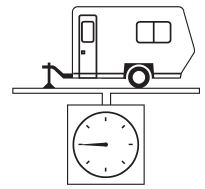
Total trailer weight
The total trailer weight (trailer weight plus its cargo load) must never exceed the maximum weight.
Legacy
The total trailer weight must not exceed 1,000 lbs (453 kg).
Outback
The maximum total trailer weight is indicated in the following tables.

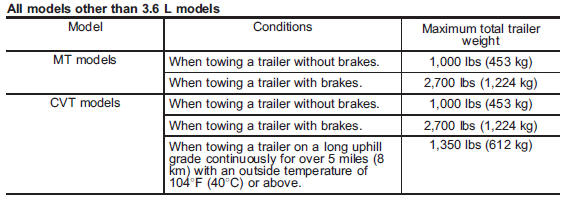
Gross Vehicle Weight (GVW) and Gross Vehicle Weight Rating (GVWR)
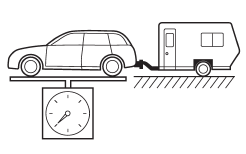
Gross Vehicle Weight
The Gross Vehicle Weight (GVW) must never exceed the Gross Vehicle Weight Rating (GVWR).
Gross Vehicle Weight (GVW) is the combined total of the weight of the vehicle, driver, passengers, luggage, trailer hitch, trailer tongue load and any other optional equipment installed on your vehicle. Therefore, the GVW changes depending on the situation. Determine the GVW each time before going on a trip by putting your vehicle and trailer on a vehicle scale. GVWR is shown on the certification label located on the driver’s door of your vehicle.
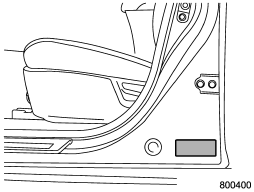
Certification label
Gross Axle Weight (GAW) and Gross Axle Weight Rating (GAWR)
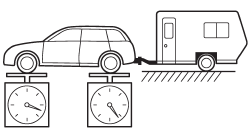
Gross Axle Weight
The total weight applied to each axle (GAW) must never exceed the Gross Axle Weight Rating (GAWR). The front and rear GAWs can be adjusted by relocating passengers and luggage inside the vehicle. The front and rear GAWR are also shown on the certification label.
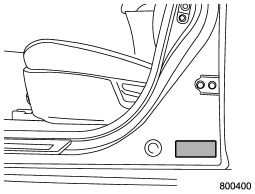
Certification label
To check both GVWR and GAWR and to confirm that the total weight and weight distribution are within safe driving limits, you should have your vehicle and trailer weighed at a commercial weighing station. Be sure that all cargo is firmly secured to prevent a change in weight distribution while driving.
Tongue load
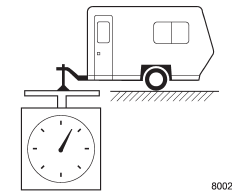
Tongue load
WARNING
If the trailer is loaded with more weight in the back of trailer’s axle than in the front, the load is taken off the rear axle of the towing vehicle. This may cause the rear wheels to skid, especially during braking or when vehicle speed is reduced during cornering, resulting in oversteer, spin out and/or jackknifing.
Ensure that the trailer tongue load is from 8 to 11 percent of the total trailer weight and does not exceed the maximum value of 200 lbs (90 kg).
NOTE
For vehicles with trailer brakes, the trailer tongue load exceeds 200 lbs (90 kg) when calculated at 8% of the maximum total trailer weight.
Even in this case, the maximum value is 200 lbs (90 kg).
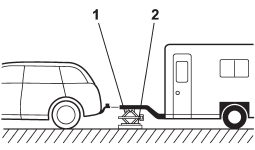
1) Jack
2) Bathroom scale
The tongue load can be weighed with a bathroom scale as shown in the following illustration. When weighing the tongue load, be sure to position the towing coupler at the height at which it would be during actual towing, using a jack as shown.
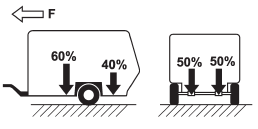
F: Front
The tongue load can be adjusted by proper distribution of the load in the trailer. Never load the trailer with more weight in the back than in the front; approximately 60 percent of the trailer load should be in the front and approximately 40 percent in the rear. Also, distribute the load as evenly as possible on both the left and right sides.
Be sure that all cargo is firmly secured to prevent a change in weight distribution while driving.
Trailer hitches
WARNING
Never drill the frame or under-body of your vehicle to install a commercial trailer hitch. If you do, dangerous exhaust gas, water or mud may enter the passenger compartment through the drilled hole. Exhaust gas contains carbon monoxide, a colorless and odorless gas which is dangerous, or even lethal, if inhaled. Also, drilling the frame or underbody of your vehicle could cause deterioration of strength of your vehicle and cause corrosion around the drilled hole.
CAUTION
● Do not modify the vehicle exhaust system, brake system, or other systems when installing a hitch or other trailer towing equipment.
● Do not use axle-mounted hitches as they can cause damage to the axle housing, wheel bearings, wheels or tires.
Choose a proper hitch for your vehicle and trailer.
Outback
The use of a genuine SUBARU trailer hitch is recommended. A genuine SUBARU hitch is available from your SUBARU dealer.
If use of a non-genuine hitch is unavoidable, be sure the hitch is suited to your vehicle and trailer. Consult with a professional hitch supplier to assist you in choosing an appropriate hitch for your vehicle. Be sure to follow all of the hitch manufacturer’s instructions for installation and use.
Never use a hitch that mounts only to the rear bumper. The bumper is not designed to handle that type of load.
For all types of hitches, regularly check that the hitch mounting bolts and nuts are tight.
Legacy
SUBARU does not offer accessory trailer hitches. Consult with a professional hitch supplier to assist you in choosing an appropriate hitch for your vehicle. Be sure to follow all of the hitch manufacturer’s instructions for installation and use. Never use a hitch that mounts only to the rear bumper. The bumper is not designed to handle that type of load.
Regularly check that the hitch mounting bolts and nuts are tight.
Connecting a trailer
Trailer brakes
WARNING
● Adequate size trailer brakes are required when the trailer and its cargo exceed 1,000 lbs (453 kg) total weight.
● Do not directly connect your trailer’s hydraulic brake system to the hydraulic brake system in your vehicle. Direct connection would cause the vehicle’s brake performance to deteriorate and could lead to an accident.
If your trailer’s total weight (trailer weight plus its cargo weight) exceeds 1,000 lbs (453 kg), the trailer is required to be equipped with its own brake system. Electric brakes or surge brakes are recommended, and must be installed properly. Check that your trailer’s brakes conform with Federal, state/province and/ or other applicable regulations. Your SUBARU’s brake system is not designed to be tapped into the trailer’s hydraulic brake system. Please ask your SUBARU dealer and professional trailer supplier for more information about the trailer’s brake system.
Trailer safety chains
WARNING
Always use safety chains between your vehicle and the trailer. Towing trailer without safety chains could create a traffic safety hazard if the trailer separates from the hitch due to coupling damage or hitch ball damage.
In case the trailer hitch connector or hitch ball should break or become disconnected, the trailer could get loose and create a traffic safety hazard. For safety, always connect the towing vehicle and trailer with trailer safety chains. Pass the chains crossing each other under the trailer tongue to prevent the trailer from dropping onto the ground in case the trailer tongue should disconnect from the hitch ball. Allow sufficient slack in the chains taking tight turn situations into account; however, be careful not to let them drag on the ground. For more information about the safety chain connection, refer to the instructions for your hitch and trailer.
Side mirrors
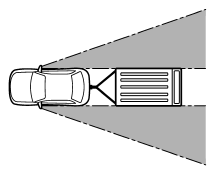
After hitching a trailer to your vehicle, check that the standard side mirrors provide a good rearward field of view without significant blind spots. If significant blind spots occur with the vehicle’s standard side mirrors, use towing mirrors that conform with Federal, state/province and/ or other applicable regulations.
Trailer lights
CAUTION
Direct splicing or other improper connection of trailer lights may damage your vehicle’s electrical system and cause a malfunction of your vehicle’s lighting system.
Connection of trailer lights to your vehicle’s electrical system requires modifications to the vehicle’s lighting circuit to increase its capacity and accommodate wiring changes. To ensure the trailer lights are connected properly, please consult your SUBARU dealer. Check for proper operation of the turn signals and the brake lights each time you hitch up.
Tires
WARNING
Never tow a trailer when the temporary spare tire is used. The temporary spare tire is not designed to sustain the towing load. Use of the temporary spare tire when towing can result in failure of the spare tire and/or less stability of the vehicle.
Make sure that all the tires on your vehicle are properly inflated. Refer to “Tires” F12- 8 and in “GAS STATION REFERENCE” at the end of this manual.
Trailer tire condition, size, load rating and proper inflation pressure should be in accordance with the trailer manufacturer’s specifications.
In the event your vehicle gets a flat tire when towing a trailer, ask a commercial road service to repair the flat tire.
If you carry a regular size spare tire in your vehicle or trailer as a precaution against getting a flat tire, be sure that the spare tire is firmly secured.
Trailer towing tips
CAUTION
● Never exceed 45 mph (72 km/h) when towing a trailer in hilly country on hot days.
● When towing a trailer, steering, stability, stopping distance and braking performance will be different from normal operation. For safety’s sake, you should employ extra caution when towing a trailer and you should never speed. You should also keep the following tips in mind:
Before starting out on a trip
● Check that the vehicle and vehicle-tohitch mounting are in good condition. If any problems are apparent, do not tow the trailer.
● Check that the vehicle sits horizontally with the trailer attached. If the vehicle is tipped sharply up at the front and down at the rear, check the total trailer weight, GVW, GAWs and tongue load again, then confirm that the load and its distribution are acceptable.
● Check that the tire pressures are correct.
● Check that the vehicle and trailer are connected properly. Confirm that
– the trailer tongue is connected properly to the hitch ball.
– the trailer lights connector is connected properly and trailer’s brake lights
illuminate when the vehicle’s brake pedal is pressed, and that the trailer’s turn
signal lights flash when the vehicle’s turn signal lever is operated.
– the safety chains are connected properly.
– all cargo in the trailer is secured safety in position.
– the side mirrors provide a good rearward field of view without a significant blind
spot.
● Sufficient time should be taken to learn the “feel” of the vehicle/trailer combination before starting out on a trip. In an area free of traffic, practice turning, stopping and backing up.
Driving with a trailer
● You should allow for considerably more stopping distance when towing a trailer.
Avoid sudden braking because it may result in skidding or jackknifing and loss of
control.
● Avoid abrupt starts and sudden accelerations. If your vehicle has a manual transmission,
always start out in first gear and release the clutch at moderate engine revolution.
● Avoid uneven steering, sharp turns and rapid lane changes.
● Slow down before turning. Make a longer than normal turning radius because the
trailer wheels will be closer than the vehicle wheels to the inside of the turn.
In a tight turn, the trailer could hit your vehicle.
● Crosswinds will adversely affect the handling of your vehicle and trailer, causing
sway. Crosswinds can be due to weather conditions or the passing of large trucks
or buses. If swaying occurs, firmly grip the steering wheel and slow down immediately
but gradually.
● When passing other vehicles, considerable distance is required because of the
added weight and length caused by attaching the trailer to your vehicle.
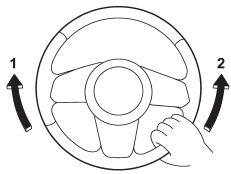
1) Left turn
2) Right turn
takes practice. When backing up with a trailer, never accelerate or steer rapidly. When turning back, grip the bottom of the steering wheel with one hand and turn it to the left for a left turn, and turn it to the right for a right turn.
● If the ABS warning light illuminates while the vehicle is in motion, stop towing the trailer and have repairs performed immediately by the nearest SUBARU dealer.
Driving on grades
● Before going down a steep hill, slow down and shift into lower gear (if necessary, use 1st gear) in order to utilize the overheating of your vehicle’s brakes. Do not make sudden downshifts.
● When driving uphill in hot weather, the air conditioner may turn off automatically to protect the engine from overheating.
● When driving uphill in hot weather, pay attention to the coolant temperature high warning light (for all models) and AT OIL TEMP warning light (for AT and CVT models) because the engine and transmission are relatively prone to overheating under these conditions. If the coolant temperature high warning light and/or the AT OIL TEMP warning light illuminates, immediately turn off the air conditioner and stop the vehicle in the nearest safe location. For further instructions and additional information, refer to the following sections.
– “If you park your vehicle in an emergency” F9-2
– “Engine overheating” F9-12
– “Coolant temperature low indicator light/Coolant temperature high warning light”
F3-13
– “AT OIL TEMP warning light (ATand CVT models)” F3-15
● For AT and CVT models, avoid using the accelerator pedal to stay stationary on an uphill slope instead of using the parking brake or foot brake. That may cause the transmission fluid to overheat.
Parking on a grade
Always block the wheels under both vehicle and trailer when parking. Apply the parking brake. You should not park on a hill or slope. But if parking on a hill or slope cannot be avoided, you should take the following steps:
1. Apply the brakes and hold the pedal down.
2. Have someone place wheel blocks under both the vehicle and trailer wheels.
3. When the wheel blocks are in place, release the regular brakes slowly until the
blocks absorb the load.
4. Apply the regular brakes and then apply the parking brake; slowly release the
regular brakes.
5. Shift into 1st or reverse gear (MT models) or “P” (AT and CVT models) and shut
off the engine.


